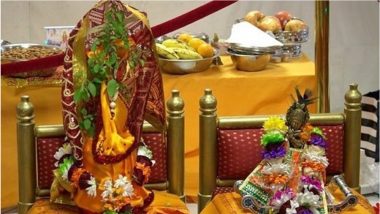In 2018, on November 19, Hindu devotees will observe Prabhodini Ekadashi and on November 20 Tulsi Vivah will be performed. Holy basil or popularly known as Tulsi in India is deemed as a sacred plant in Hinduism and is found in almost every household as it symbolises purity and is famous for its medicinal properties. On the eleventh day of Shukla Paksha on Prabhodini Ekadashi, also known as Gyaras, or the twelfth day during the month of Kartik, Tulsi Vivah or the marriage of Tulsi with Lord Vishnu is performed. Below we tell you the shubh muhurat or the auspicious time to conduct the Tulsi Vivah, the puja vidhi and the significance behind observing the ritual.
Story of Tulsi Vivah
It is believed that Tulsi is an incarnation of Goddess Lakshmi, consort of Lord Vishnu. She is also called as ‘Vishnu Priya’ literally meaning ‘the beloved of Vishnu’. According to Hindu mythology, there was a woman named Brinda who was whole heartedly devoted to a demon king and husband Jalandhar. Jalandhar wanted to destroy all the Gods. There was no way to kill Jalandhar until his wife remained faithful to him. Lord Vishnu then disguised himself as Jalandhar and spent a night with Brinda. Upon knowing that her chastity and devotion had been destroyed, angry Brinda cursed Vishnu that he would become a black stone (known as Shaligram). Jalandhar lost his battle with the Gods and was eventually killed, and Brinda jumped into the funeral pyre of her husband.
To compensate to Brinda, Lord Vishnu transformed her soul to a Tulsi plant and said that he would marry her in the next birth. Vishnu in the form of Shaligram stone got married to the Tulsi plant on the day of Prabhodhini Ekadashi. This day is celebrated in the form of Tulsi Vivah by the Hindus. The Tulsi Vivah signifies the end of the monsoon and the beginning of the Hindu wedding season. The meaning of marriage in Hinduism is the merging and oneness of the embodied soul and God.
Tulsi Vivah Puja Time (According to Drik Panchang)
Dwadashi Tithi Begins – 02:29 pm on November 19
Dwadashi Tithi Ends – 02:40 pm on November 20
Tulsi Vivah Puja Vidhi
On the day of the puja, devotees wake up early and take bath. A Tulsi pot is placed in the centre of the house and given a holy bath and decorated with items like vermillion, turmeric, sacred thread, and flowers. The idol of Krishna or Shaligram is decorated and placed adjacent to the Tulsi plant and preparations for the marriage ceremony begin. Many devotees also observe a long day fast and the vivah takes place in the evening. After invoking the presence of Tulsi and Krishna, the mantras are chanted, and a cotton thread is tied around the statue and the plant as a mark of the wedding.
Tulsi Vivah is conducted in both homes and temples. It is believed that performing Tulsi Vivah is auspicious for childless couples. They perform the role of Tulsi’s parents and give their daughter in marriage to Lord Krishna. Prabhodhini Ekadashi is also known as Dev Uthani Ekadashi and Devutthana Ekadashi.
(The above story first appeared on LatestLY on Nov 19, 2018 09:11 AM IST. For more news and updates on politics, world, sports, entertainment and lifestyle, log on to our website latestly.com).













 Quickly
Quickly





















